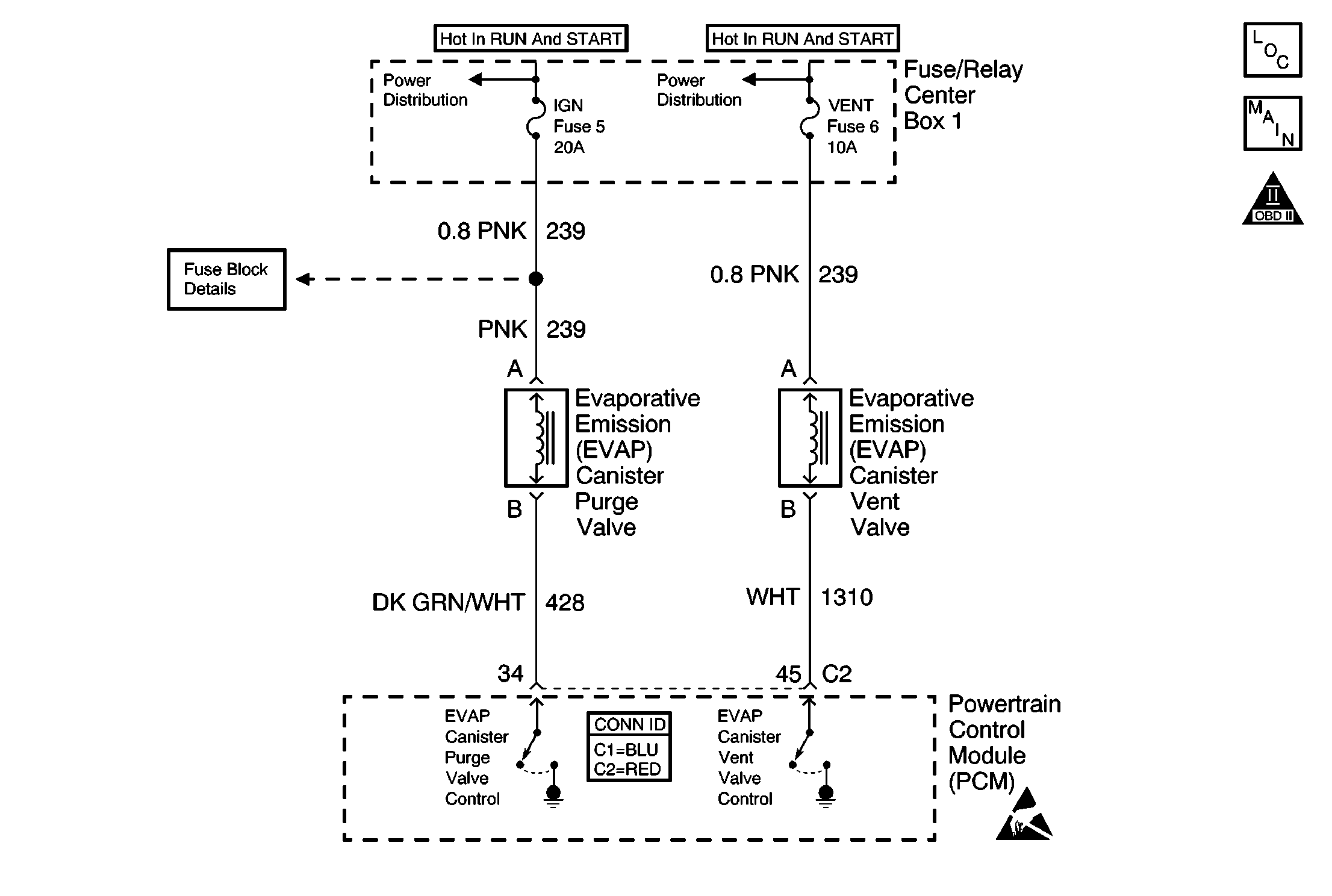
Circuit Description
A voltage is supplied directly to the evaporative emission (EVAP) canister vent valve . The powertrain control module (PCM) controls the solenoid by grounding the control circuit via an internal switch called a driver. The primary function of the driver is to supply the ground for the controlled component. Each driver has a fault line which the PCM monitors. The voltage of the control circuit should be near 0 volts when the PCM commands a component ON. The voltage potential of the circuit should be near the battery voltage when the PCM commands the control circuit to a component OFF. If the fault detection circuit senses a voltage other than what the PCM is expects, the fault line status changes causing the DTC to set.
Conditions for Running the DTC
| • | The engine speed is more than 400 RPM. |
| • | The ignition voltage is between 6.0 volts and 18.0 volts. |
Conditions for Setting the DTC
| • | The PCM detects that the commanded state of the driver and the actual state of the control circuit do not match. |
| • | The conditions are present for a minimum of 5.0 seconds. |
Action Taken When the DTC Sets
| • | The powertrain control module (PCM) stores the DTC information into memory when the diagnostic runs and fails. |
| • | The malfunction indicator lamp (MIL) will not illuminate. |
| • | The PCM records the operating conditions at the time the diagnostic fails. The PCM stores this information in the Failure Records. |
Conditions for Clearing the DTC
| • | A last test failed, or current DTC, clears when the diagnostic runs and does not fail. |
| • | A history DTC will clear after 40 consecutive warm-up cycles, if no failures are reported by this or any other non-emission related diagnostic. |
| • | Use a scan tool in order to clear the DTC. |
Diagnostic Aids
Important:
• Remove any debris from the PCM connector surfaces before servicing
the PCM. Inspect the PCM connector gaskets when diagnosing or replacing the
PCM. Ensure that the gaskets are installed correctly. The gaskets prevent
water intrusion into the PCM. • For any test that requires probing the PCM or a component
harness connector, use the J 35616
connector test adapter kit. Using this kit prevents damage
to the harness and component terminals. Refer to
Using Connector Test Adapters
in Wiring Systems.
| • | Test the solenoid ignition feed circuit and control circuit for excessive resistance if an audible click cannot be heard when the solenoid is commanded ON and OFF. |
| • | Using Freeze Frame and/or Failure Records data may aid in locating an intermittent condition. If you cannot duplicate the DTC, the information included in the Freeze Frame and/or Failure Records data can aid in determining how many miles since the DTC set. The Fail Counter and Pass Counter can also aid determining how many ignition cycles the diagnostic reported a pass and/or a fail. Operate the vehicle within the same Freeze Frame conditions, such as RPM, load, vehicle speed, temperature, that you observed. This will isolate when the DTC failed. |
| • | For an intermittent, refer to Symptoms . |
Test Description
The numbers below refer to the step numbers on the diagnostic table.
-
Listen for an audible click when the solenoid operates. Be sure that both the ON and the OFF states are commanded. Repeat the commands as necessary.
-
This step tests for voltage at the coil side of the EVAP vent solenoid. The ENG CNTRL fuse supplies power to the EVAP vent solenoid.
-
This step verifies that the PCM is providing ground to the EVAP vent solenoid.
-
This step tests if a ground is constantly being applied to the EVAP vent solenoid.
Step | Action | Values | Yes | No |
|---|---|---|---|---|
1 | Did you perform the Powertrain On-Board Diagnostic (OBD) System Check ? | -- | ||
Does the solenoid turn ON and OFF when commanded? | -- | |||
3 |
Does this DTC reset? | -- | Go to Diagnostic Aids | Go to Intermittent Conditions |
Does the test lamp illuminate? | -- | |||
Does the test lamp turn ON and OFF with each command? | -- | |||
Does the test lamp remain illuminated with each command? | -- | |||
7 |
Did you find and correct the condition? | -- | ||
8 |
Did you find and correct the condition? | -- | ||
9 |
Did you find and correct the condition? | -- | ||
10 |
Did you find and correct the condition? | -- | ||
11 | Repair the coil side feed circuit of the EVAP vent solenoid. Refer to Wiring Repairs in Wiring Systems . Is the action complete? | -- | -- | |
12 | Replace the EVAP vent solenoid. Refer to Evaporative Emission Vent Valve Replacement . Is the action complete? | -- | -- | |
13 |
Important:: The replacement PCM must be programmed. Replace the PCM. Refer to Powertrain Control Module Replacement/Programming . Is the action complete? | -- | -- | |
14 |
Does the DTC reset? | -- | ||
15 | With a scan tool, review the Stored Information or capture info. Does the scan tool display any DTCs that you have not diagnosed? | -- | System OK |
